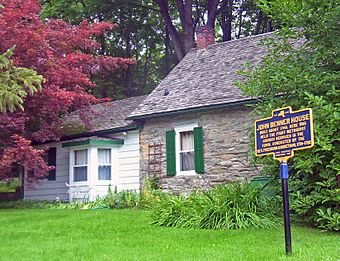Benner House facts for kids
Quick facts for kids |
|
|
Benner House
|
|

Partial north elevation with state historical marker, 2008
|
|
| Location | Rhinebeck, NY |
|---|---|
| Nearest city | Kingston |
| Built | c. 1739 |
| Architect | Johannes Benner |
| MPS | Rhinebeck Town MRA |
| NRHP reference No. | 87001067 |
| Added to NRHP | July 9, 1987 |
The Benner House is a very old home located on Mill Street in Rhinebeck, New York, United States. It was built by Johannes Benner, a German immigrant, in the 1730s. This makes it the oldest house in the Village of Rhinebeck!
The Benner House is special because it's a rare example of a stone house built with German traditions in the Hudson Valley. Most houses from that time were built in the Dutch style. It's the only house with its unique floor plan left in Rhinebeck. Because of its history and special design, it was added to the National Register of Historic Places in 1987.
Contents
Discover the Benner House
The Benner House sits where Mill Road and Route 9 meet, at the southern edge of Rhinebeck village. The back of the house faces Mill Street. This means people driving south on the highway can easily see it. The land around the house is mostly covered with trees. However, there's an open space in front. This open area lets you see the road and the valley. A modern garage, built in 1938, is also on the property. This garage is not part of the historic listing.
What Does the Benner House Look Like?
The Benner House is a one-and-a-half-story rectangular home. It has a pointed roof, called a gable roof. The front of the house has a special door called a Dutch door. This door is not exactly in the middle. The windows nearby have stone frames that flare out. A porch with a flat roof covers the entire front of the house. This porch has square columns and a shallow arch design. On the back, there's a wooden wing with a less steep roof. This wing shows two attic windows on the main part of the house above it.
A Peek into Benner House History
The Benner House has a long and interesting past. It has seen many changes over the centuries. Learning about its history helps us understand what life was like long ago.
Who Built the Benner House?
Johannes Benner, also known as Bender, came to the Hudson Valley with his family. They moved from a place called Upper Bavaria in Germany in the early 1700s. People in the area believe that Johannes or someone in his family built the house around 1740. However, there are no old papers that officially confirm this date. Johannes Benner rented the land from Henry Beekman. It's also thought that the very first meetings of the local Methodist church happened in this house. This was around 1791 or 1792. The oldest known record of ownership shows that S.S. Myers owned the house in 1797.
How Did the House Change Hands?
By 1850, a well-known family called the Livingston family owned the Benner House. They used it as a support building for their large Grasmere estate nearby. Some people even thought it was once a writing school. In 1874, a woman named Ann O'Brien bought the house. When she passed away in 1900, her son, Thomas O'Brien, inherited the property. Thomas was a veteran of the Civil War. After Thomas O'Brien died in 1946, his two daughters, Ann Gregory and Mary Sullivan, took ownership. The house then had several other owners through the late 1900s.
What Was Stored in the Attic?
An old newspaper, the Rhinebeck Gazette, wrote about the house in 1929. It mentioned that there were special bins found in the attic, or "garret," of the house. These bins were used to store grain. People used to think they were to keep grain safe from Native Americans. However, there were more practical reasons. Storing grain in the attic kept it safer from rodents than in a barn. It was also a drier place. Even when the house didn't need heating, a fire for cooking was always burning in the fireplace. This helped keep the attic dry.

